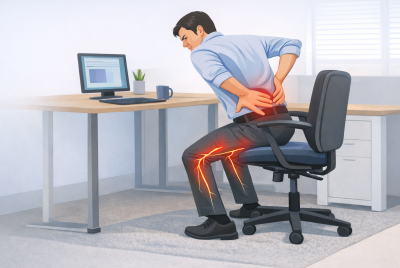SI Joint Pain with Sciatica
Discover effective ways to manage SI joint pain with sciatica. Learn lifestyle changes, therapies, and tips for relief. Dive in now! As someone who has experienced the challenges of SI joint pain and sciatica firsthand, I understand the frustration and discomfort that come with these conditions. In this article, I’ll delve into the intricacies of SI joint pain and sciatica, offering insights, tips, and personal experiences to help you navigate your journey towards relief and recovery.
Introduction
SI joint pain and sciatica are two common yet often misunderstood conditions that can significantly impact daily life. While their symptoms may share similarities, understanding the differences between them is crucial for effective management and treatment.
Understanding SI Joint Pain
The sacroiliac joint, or SI joint, connects the spine to the pelvis. When this joint becomes inflamed or dysfunctional, it can cause pain and discomfort in the lower back, buttocks, and thighs. Common causes of SI joint pain include injury, arthritis, pregnancy, and biomechanical issues.
Understanding Sciatica
Sciatica refers to pain that radiates along the path of the sciatic nerve, which runs from the lower back down the back of each leg. This pain is typically caused by compression or irritation of the sciatic nerve, often due to a herniated disc, spinal stenosis, or muscle tightness.
Symptoms of SI Joint Pain and Sciatica
Due to their overlapping symptoms, differentiating between SI joint pain and sciatica can be challenging. However, certain clues, such as the location and nature of the pain, can help distinguish between the two conditions. Common symptoms include lower back pain, buttock pain, leg pain, numbness, and tingling.
The Connection Between SI Joint Pain and Sciatica
Diagnosis
Diagnosing SI joint pain and sciatica typically involves a combination of medical history, physical examination, and diagnostic tests such as X-rays, MRI, and CT scans. Identifying the underlying cause of the symptoms is essential for developing an appropriate treatment plan.
Treatment Options
Treatment options vary depending on the severity and underlying cause of the symptoms. Conservative options such as rest, ice, heat, and over-the-counter medications may provide relief for mild cases. Physical therapy, chiropractic care, injections, and surgical interventions may be recommended for more severe cases.
Lifestyle Changes
Lifestyle changes play a crucial role in managing the pain. Regular exercise, focusing on low-impact activities like yoga or tai chi, can improve strength and flexibility while reducing pain. Maintaining proper posture, especially when sitting or standing for extended periods, helps alleviate pressure on the spine. Ergonomic adjustments, such as using supportive chairs and avoiding heavy lifting, can prevent exacerbation of symptoms. Weight management through a balanced diet and portion control reduces stress on the joints. Incorporating stress-reducing techniques like meditation or deep breathing promotes relaxation and eases tension. Individuals can effectively manage the pain by making these lifestyle changes and improving their overall well-being.
Preventive Measures
Taking proactive steps to prevent this can help minimize the risk of recurrence and maintain long-term spinal health. Engaging in regular exercise, practicing good posture, and avoiding activities that strain the back are essential preventive measures.
Personal Experience
Having personally dealt with this pain, I understand the importance of patience, perseverance, and self-care in managing these conditions. Through trial and error, I’ve discovered various strategies and techniques that have helped me find relief and regain control of my life.
Tips for Managing SI Joint Pain and Sciatica
Managing the pain requires a multifaceted approach. Regular exercise, such as walking or swimming, can strengthen muscles and improve flexibility. Practicing good posture and ergonomic adjustments, like using lumbar support, can alleviate strain on the spine. Heat and cold therapy can reduce inflammation and relieve pain through heating pads or ice packs. Mindfulness techniques, such as deep breathing or meditation, can help manage stress and promote relaxation. Additionally, maintaining a healthy weight and avoiding activities that exacerbate symptoms are essential. By incorporating these tips into daily life, individuals can effectively manage the pain and enhance their quality of life.
Seeking Professional Help
While self-care strategies can be beneficial, seeking professional help from healthcare providers is essential for proper diagnosis and treatment. Whether it’s consulting with a primary care physician, orthopedic specialist, or physical therapist, finding the right healthcare team can make all the difference in your journey towards recovery.
Alternative Therapies
In addition to conventional medical treatments, Alternative therapies offer additional relief for this pain. Chiropractic care can alleviate discomfort by requiring manual adjustments to improve joint function. Acupuncture, by stimulating specific points on the body, may reduce pain and promote relaxation. Massage therapy, through kneading and manipulation of muscles, can ease tension and improve circulation. Integrating these complementary approaches into a treatment plan can enhance overall well-being and alleviate symptoms associated with the pain, providing patients with alternative options for managing their condition.
The Role of Nutrition
Nutrition plays a crucial role in supporting overall health and managing inflammation associated with SI joint pain and sciatica. Adopting an anti-inflammatory diet rich in fruits, vegetables, whole grains, and lean proteins, as well as incorporating supplements such as natural blends, omega-3 fatty acids, and turmeric, can help reduce pain and promote healing.
Support Systems
Living with SI joint pain can be challenging, but you don’t have to face it alone. Joining support groups, connecting with others who share similar experiences, and seeking support from friends and family can provide comfort, encouragement, and invaluable resources along your journey.
Frequently Asked Questions (FAQs)
Can SI joint pain and sciatica be cured completely?
While a complete cure may not always be possible, effective management strategies can significantly reduce symptoms and improve quality of life.
Is surgery always necessary for treating SI joint pain and sciatica?
Surgery is typically considered a last resort when conservative treatments fail to provide relief or when there is significant structural damage requiring surgical intervention.
How long does it take to recover from SI joint pain and sciatica?
Recovery time varies depending on the severity of the condition, individual factors, and the chosen treatment approach. Some people may experience relief within a few weeks, while others may require more prolonged treatment and rehabilitation.
Can SI joint pain and sciatica be prevented?
While it may not always be possible to prevent these conditions entirely, adopting healthy lifestyle habits, practicing good posture, and avoiding activities that strain the back can help reduce the risk of developing this pain.
Are there any exercises that can help relieve SI joint pain and sciatica?
Yes, specific exercises and stretches targeting the core, hips, and lower back can help strengthen muscles, improve flexibility, and alleviate pain associated with SI joint pain and sciatica. However, it’s essential to consult with a healthcare professional before starting any new exercise regimen.
Conclusion
In conclusion, navigating the complexities of SI joint pain and sciatica requires patience, perseverance, and a comprehensive approach to treatment and management. By understanding the underlying causes, implementing lifestyle modifications, seeking professional help, and exploring alternative therapies, you can take control of your symptoms and reclaim your quality of life.
Disclaimer
This article is for informational purposes only and is not a substitute for professional medical advice, diagnosis, or treatment. Always consult with your healthcare provider before starting a new exercise or stretching routine, especially if you have existing back or nerve conditions.
👉 Explore more:
- Newly Discovered Weird Stretch Fixes Back Pain and Sciatica Fast
- Treatment for Sciatica Pain in Hip and Leg
- Will Sciatica Go Away





